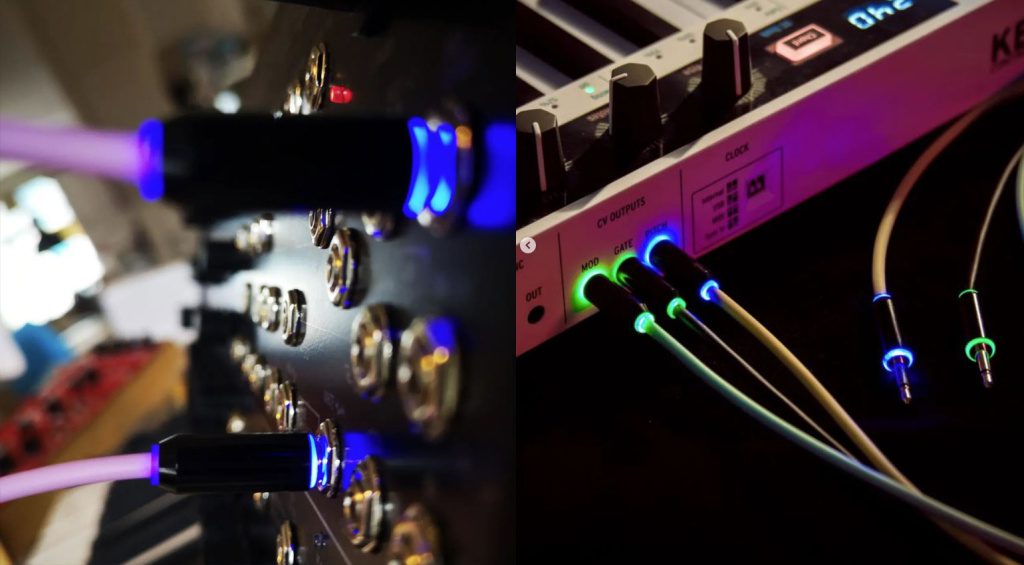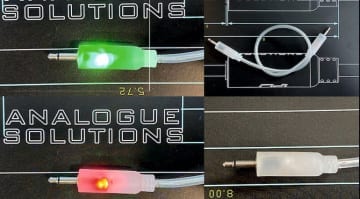Halo: Light-up patch cables done right from myVolts and Andrew Huang
Andrew Huang and MyVolts have got together to produce the best-looking light-up patch cables you’ve ever seen. This is the way to do it.
Halo
We love flashing lights in Eurorack. Any excuse to add further illumination is always a good thing. We’ve seen light-up patch cables before, it’s not a new idea, and I’ve got a few knocking around in my rack. But they’ve lacked a bit of finesse and always feel a little clunky. Halo hopes to change that.
Halo cables are based on myVolts Candycord patch cables but with magic infused into the ends. As voltage passes through, the value of the signal is visualised with LEDs embedded into the plug. What’s different about this to other light-up patch cables is that the light only emerges from the top and bottom of the plug in a rather nice halo. It looks completely awesome.
The cables are made with thermoplastic rubber sleeving, which adds durability but also makes them a little on the chunky side. The plugs use anodised aluminium casing, and the connector on the end is gold plated. I get the feeling that these are going to be expensive.
Click on the button below to load the contents of www.kickstarter.com.
Visualising
I think visual feedback is an awesome thing as you’ll have gathered from my Molten Motion Meter module that was released yesterday. Each Halo has matching bi-colour LEDs at either end. The brightness shows the strength of CV, and it flips colour between positive and negative signals. There are two choices of LED bi-colour depending on the colour of cable you buy. Pink, Peach, Purple and Black cables get Blue/Red, whereas Yellow, Green and Grey cables get Red/Green. At high frequencies, these are seen as Purple or Yellow.
These are going to be great for better understanding what’s going on in your patch as well as looking fabulous. There’s always a caveat with light-up cables in that because they are passive, they have to draw power from the CV that’s passing through; however, this is tiny. It will make no difference to regular modulation, triggers or clocks, but it does depend on the complexity of what you’re doing.
Pricing
Candycords are quite a premium cable to begin with; like $10 for a 15cm stereo minijack cable. But they are rather nice. The first entry into Halo is a twin pack of any size for €19 plus shipping. Sizes on offer are 15cm, 30cm, 50cm and 80cm. A pack of 4 pairs will cost you €75. A 5-pack of braided patch cables would commonly cost you around 20 quid. So these are definitely on the premium side of posh.
Halo is on Kickstarter now, and they are not quite halfway to the goal with 16 days to do. With Andrew Huang’s influence, I’m surprised they didn’t hit it almost immediately, but then these are for people who use their own modular rather than people who enjoy watching Andrew use his. Andrew did allude to stretch goals in the video, but there’s nothing on the Kickstarter page about it that I can see. I’m sure it will pick up, and I am definitely tempted to get a couple.
- MyVolts Halo: MyVolts
6 responses to “Halo: Light-up patch cables done right from myVolts and Andrew Huang”
 3,6 / 5,0 |
3,6 / 5,0 | 












voltage drop
As they say, the voltage drop is pretty negligible. On the Kickstarter page they talk about the testing and how lengthening the cable actually had a bigger effect on signal loss than turning on the LEDs. So, yes, voltage is being used but for most people, in most scenarios, it’s not really a thing.
ok
I wouldn’t use such a cable for v/oct though.
And you don’t have to, and probably you would most likely be using them for visualising modulation
perfect for the J.C. Whitney synth aficionado; put LED’s on everything.
where’s the smoke machine?
this will be your legacy Andrew